Integration of Emergy Analysis with Building Information Modeling
Abstract
:1. Introduction
2. Background
3. Framework Development
3.1. Limitations of BIM-Based Energy Analysis and EmA a Potential Alternative
3.2. Emergy Integration with BIM- A Conceptual Framework
- Identification of the input properties
- Computation of the transformity
- Calculation of emergy values for different life-cycle phases
- Computation of total emergy
- (i)
- Identification of the input properties
- (ii)
- Identification of the Transformity
- (a)
- API-based data exchange
- (b)
- gbXML-enabled data exchange
- (c)
- IFC-enabled data exchange
- (iii)
- Calculation of Emergy for different phases
- natural resource formation
- natural resource exploration and extraction
- material production
- design
- component production
- construction (assembly)
- use
- demolition
- natural resource recycling
- disposal
4. Case Study and Evaluation
- Building use was not considered
- The information presented in BIM software library (Revit® 2021 library) were used as standards for the materials used in this case study
- The case study used the transformity values from [15]
4.1. Computation of the Material’s Weight
4.2. Computing Transformity in Revit® 2021
5. Discussion and Conclusions
6. Limitations and Future Work
- (i)
- Interoperability: The information (such as weight of the material and transformity) flow between BIM tools and transformity library is a challenge in emergy computation as discussed on the case study. The degree of challenge varies depending on the type of BIM tools used. Currently, most of the BIM tools do not have a transformity library. Therefore, the addition of a transformity library to BIM tools will be useful for AEC stakeholders. With the addition of the transformity library, emergy analysis within BIM tools can become seamless.
- (ii)
- Accuracy of transformity: The value of transformity is developed using the empirical method. It is difficult to account for all the energy requirement in the formation of natural resources. So, the accuracy of these empirically developed transformity value can sometimes be debated.
- (iii)
- Availability of accurate density values: The density of material obtained from the BIM library may not always be of correct value. So, verifying the density value of the material used in the design and construction of building can be an esoteric process.
- (iv)
- Too many materials to account: The construction of building involves a lot of materials. Accounting these material’s corresponding weight and transformity value can sometimes be a challenge.
- (v)
- lengthy process: Overall emergy calculation process is lengthy. It is required to check materials properties such as density, volume, and transformity. For the accurate emergy value, it is important to include all the material used in the building which makes this a very lengthy process.
Author Contributions
Funding
Institutional Review Board Statement
Informed Consent Statement
Conflicts of Interest
References
- Rasiah, R.; Kari, F.; Sadoi, Y.; Mintz-Habib, N. Climate change and sustainable development issues: Arguments and policy initiatives. J. Asia Pac. Econ. 2018, 23, 187–194. [Google Scholar] [CrossRef]
- Li, D.H.W.; Yang, L.; Lam, J.C. Impact of climate change on energy use in the built environment in different climate zones—A review. Energy 2012, 42, 103–112. [Google Scholar] [CrossRef]
- EIA Projects 48% Increase in World Energy Consumption by 2040—Today in Energy—U.S. Energy Information Administration (EIA). Available online: https://www.eia.gov/todayinenergy/detail.php?id=26212 (accessed on 6 August 2020).
- About LEED® and Campus. Sustainability.pdf. Available online: https://s3.amazonaws.com/legacy.usgbc.org/usgbc/docs/Archive/General/Docs4045.pdf (accessed on 20 July 2020).
- Gulbinas, R.; Khosrowpour, A.; Taylor, J. Segmentation and Classification of Commercial Building Occupants by Energy-Use Efficiency and Predictability. IEEE Trans. Smart Grid 2015, 6, 1414–1424. [Google Scholar] [CrossRef]
- Ritchie, H.; Roser, M. CO₂ and Greenhouse Gas Emissions. 2017. Available online: https://ourworldindata.org/co2-and-other-greenhouse-gas-emissions (accessed on 20 July 2020).
- Kibert, C.J. Sustainable Construction: Green Building Design and Delivery; John Wiley & Sons: Hoboken, NJ, USA, 2016. [Google Scholar]
- LEED by the Numbers: 16 Years of Steady Growth U.S. Green Building Council. Available online: https://www.usgbc.org/articles/leed-numbers-16-years-steady-growth (accessed on 6 August 2020).
- Miller, R.F. An Environmental Value Engineering (EVE) Analysis of the Environmental Impacts of Component Production for Traditional Wood-Framed and Structural-Insulated Panel Wall Systems. Ph.D. Thesis, Indiana State University, Terre Haute, IN, USA, 2013. [Google Scholar]
- Brown, M.T.; Herendeen, R.A. Embodied energy analysis and EMERGY analysis: A comparative view. Ecol. Econ. 1996, 19, 219–235. [Google Scholar] [CrossRef]
- Vilches, A.; Garcia-Martinez, A.; Sanchez-Montañes, B. Life cycle assessment (LCA) of building refurbishment: A literature review. Energy Build. 2017, 135, 286–301. [Google Scholar] [CrossRef]
- Elsayed, I.; Nishi, Y. Emergy and Sustainability Ternary Diagrams of Energy Systems: Application to Solar Updraft Tower. Sustainability 2020, 12, 10546. [Google Scholar] [CrossRef]
- Roudebush, W.H. Environmental Value Engineering (EVE): An Environmental Life Cycle Assessment Methodology for Comparing Built-Environment Alternatives; ASEE: Nashville, TN, USA, 2003; pp. 8.529.1–8.529.8. [Google Scholar]
- Nadalini, A.C.V.; Kalid, R.D.A.; Torres, E.A. Emergy as a Tool to Evaluate Ecosystem Services: A Systematic Review of the Literature. Sustainability 2021, 13, 7102. [Google Scholar] [CrossRef]
- Roudebush, W.H. Environmental Value Engineering (EVE): A System for Analyzing the Environmental Impact of Built Environment Alternatives. Ph.D. Thesis, University of Florida, Gainesville, FL, USA, 1992. Available from Dissertations & Theses @ University of Florida—FCLA; ProQuest Dissertations & Theses Global. (303981639).. Available online: https://login.lp.hscl.ufl.edu/login?url=https://www.proquest.com/dissertations-theses/environmental-value-engineering-eve-system/docview/303981639/se-2?accountid=10920 (accessed on 22 June 2020).
- Odum, H.T. Energy, Ecology, and Economics. Ambio 1973, 2, 220–227. [Google Scholar]
- Odum, H.T. Environmental Accounting: Emergy and Environmental Decision Making; Wiley: Hoboken, NJ, USA, 1996; ISBN 978-0-471-11442-0. [Google Scholar]
- Ahmadi, M.; Hatami, M.; Rahgozar, P.; Shirkhanloo, S.; Abed, S.; Kamalzadeh, H.; Flood, I. Development of an ESCO Risk Assessment Model as a Decision-Making Tool for the Energy Savings Certificates Market Regulator: A Case Study. Appl. Sci. 2020, 10, 2552. [Google Scholar] [CrossRef] [Green Version]
- Shadram, F.; Johansson, T.; Lu, W.; Schade, J.; Olofsson, T. An Integrated BIM-based framework for minimizing embodied energy during building design. Energy Build. 2016, 128, 592–604. [Google Scholar] [CrossRef]
- Herendeen, R. System-level indicators in dynamic ecosystems: Comparison based on energy and nutrient flows. J. Theor. Biol. 1990, 143, 523–553. [Google Scholar] [CrossRef]
- Ramesh, T.; Prakash, R.; Shukla, K.K. Life cycle energy analysis of buildings: An overview. Energy Build. 2010, 42, 1592–1600. [Google Scholar] [CrossRef]
- Zhao, Z.-Y.; Zhu, J.; Zuo, J. Sustainable development of the wind power industry in a complex environment: A flexibility study. Energy Policy 2014, 75, 392–397. [Google Scholar] [CrossRef]
- Anand, C.K.; Amor, B. Recent developments, future challenges and new research directions in LCA of buildings: A critical review. Renew. Sustain. Energy Rev. 2017, 67, 408–416. [Google Scholar] [CrossRef]
- Dixit, M.K. Life cycle embodied energy analysis of residential buildings: A review of literature to investigate embodied energy parameters. Renew. Sustain. Energy Rev. 2017, 79, 390–413. [Google Scholar] [CrossRef]
- Dixit, M.K.; Fernández-Solís, J.L.; Lavy, S.; Culp, C.H. Identification of parameters for embodied energy measurement: A literature review. Energy Build. 2010, 42, 1238–1247. [Google Scholar] [CrossRef]
- Dixit, M.K.; Fernández-Solís, J.L.; Lavy, S.; Culp, C.H. Need for an embodied energy measurement protocol for buildings: A review paper. Renew. Sustain. Energy Rev. 2012, 16, 3730–3743. [Google Scholar] [CrossRef]
- Fernandez, J. Materials and Construction for Low-Energy Buildings in China. In Sustainable Urban Housing in China: Principles and Case Studies for Low-Energy Design; Glicksman, L., Lin, J., Eds.; Alliance for Global Sustainability Bookseries; Springer: Dordrecht, The Netherlands, 2006; pp. 44–73. [Google Scholar] [CrossRef]
- Katranuschkov, P.; Scherer, R.J.; Weise, M.; Liebich, T. Extending BIM for Energy Simulation and Design Tasks. Comput. Civ. Build. Eng. 2014, 2014, 625–632. [Google Scholar]
- Moreno, C.; Olbina, S.; Issa, R.R. BIM Use by Architecture, Engineering, and Construction (AEC) Industry in Educational Facility Projects. Available online: https://www.hindawi.com/journals/ace/2019/1392684/ (accessed on 25 June 2020).
- GSA_BIM_Guide_v0_60_Series01_Overview_05_14_07.pdf. Available online: https://www.gsa.gov/cdnstatic/GSA_BIM_Guide_v0_60_Series01_Overview_05_14_07.pdf (accessed on 22 June 2020).
- Azhar, S.; Brown, J.; Farooqui, R. BIM-Based Sustainability Analysis: An Evaluation of Building Performance Analysis Software. In Proceedings of the 45th ASC Annual Conference, Gainesville, FL, USA, 5–9 April 2009; Volume 1, pp. 276–292. [Google Scholar]
- Kim, H.; Anderson, K.; Lee, S.; Hildreth, J. Generating construction schedules through automatic data extraction using open BIM (building information modeling) technology. Autom. Constr. 2013, 35, 285–295. [Google Scholar] [CrossRef]
- Gordon, C.; Azambuja, M.; Werner, A.M. BIM across the construction curriculum. In Proceedings of the ASC Region III Conference, Downers Grove, IL, USA; 2009. [Google Scholar]
- Azhar, S. Building Information Modeling (BIM): Trends, Benefits, Risks, and Challenges for the AEC Industry. Leadersh. Manag. Eng. 2011, 11, 241–252. [Google Scholar] [CrossRef]
- Jalaei, F.; Jrade, A. Integrating Building Information Modeling (bim) and Energy Analysis Tools with Green Building Certification System to Conceptually Design Sustainable Buildings. J. Inf. Technol. Constr. 2014, 19, 494–519. [Google Scholar]
- Krygiel, E.; Nies, B. Green BIM: Successful Sustainable Design with Building Information Modeling; John Wiley & Sons: Hoboken, NJ, USA, 2008. [Google Scholar]
- Raftery, P.; Keane, M.; O’Donnell, J. Calibrating whole building energy models: An evidence-based methodology. Energy Build. 2011, 43, 2356–2364. [Google Scholar] [CrossRef]
- Sartori, I.; Hestnes, A.G. Energy use in the life cycle of conventional and low-energy buildings: A review article. Energy Build. 2007, 39, 249–257. [Google Scholar] [CrossRef]
- Li, H.X.; Ma, Z.; Liu, H.; Wang, J.; Al-Hussein, M.; Mills, A. Exploring and verifying BIM-based energy simulation for building operations. Eng. Constr. Archit. Manag. 2020. [Google Scholar] [CrossRef]
- Clarke, J.A.; Clarke, J.A. Energy Simulation in Building Design; Routledge: Abingdon, UK, 2001. [Google Scholar]
- Roudebush, W. Environmental Value Engineering: An Environmental Life Cycle Assessment Methodology For Comparing Built Environment Alternatives. In Proceedings of the 2003 American Society for Engineering Education Annual Conference & Exposition, Nashville, TN, USA, 25 June 2003. [Google Scholar]
- Available online: http://www.nrmca.org/taskforce/item_2_talkingpoints/sustainability/sustainability/sn2088.pdf (accessed on 22 June 2020).
- Herendeen, R.A. Energy analysis and EMERGY analysis—A comparison. Ecol. Model. 2004, 178, 227–237. [Google Scholar] [CrossRef]
- Ham, Y.; Golparvar-Fard, M. Mapping actual thermal properties to building elements in gbXML-based BIM for reliable building energy performance modeling. Autom. Constr. 2015, 49, 214–224. [Google Scholar] [CrossRef]
- (PDF) Model View Definition for Advanced Building Energy Performance Simulation. Available online: https://www.researchgate.net/publication/308614558_Model_View_Definition_for_Advanced_Building_Energy_Performance_Simulation (accessed on 3 July 2020).
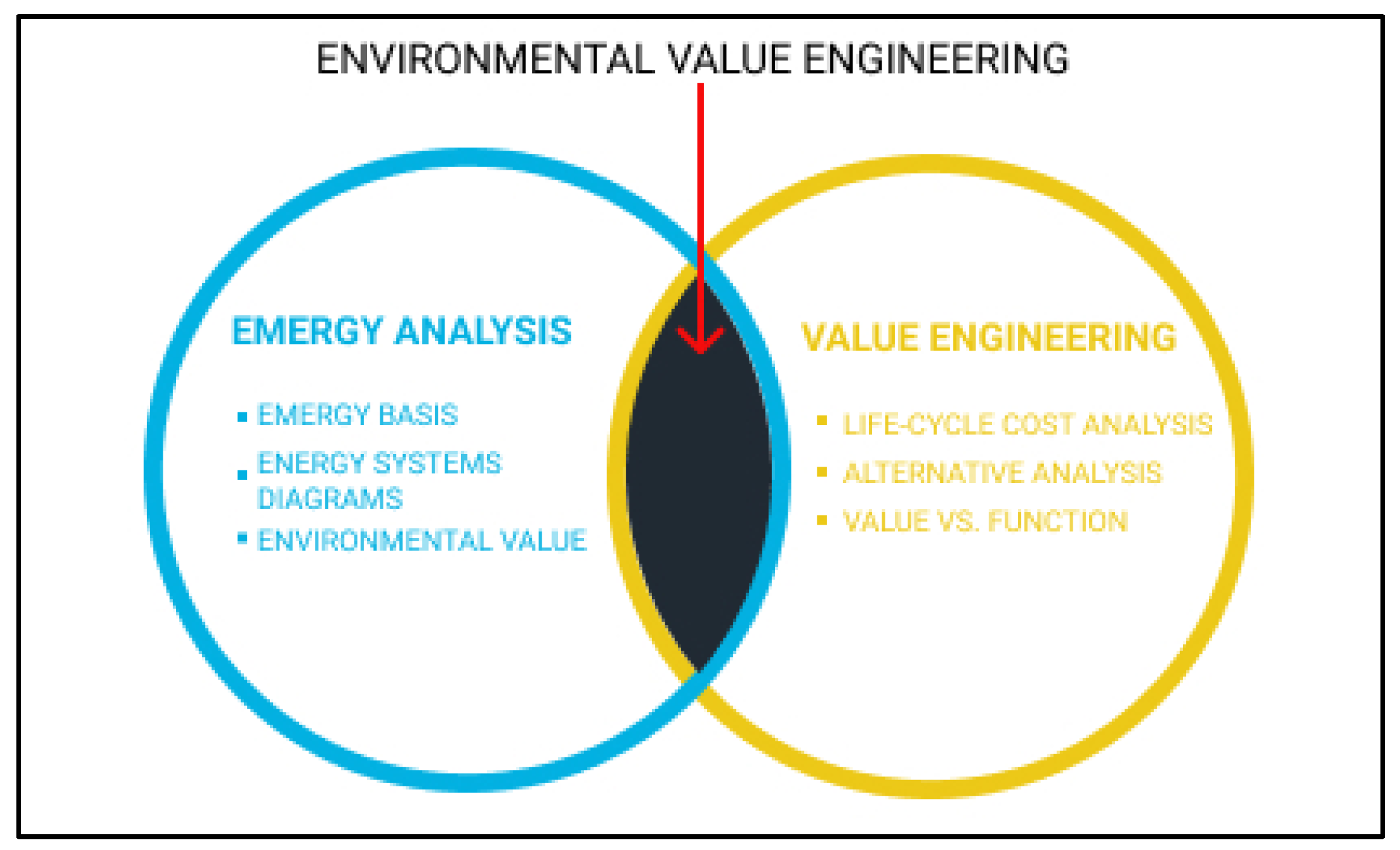
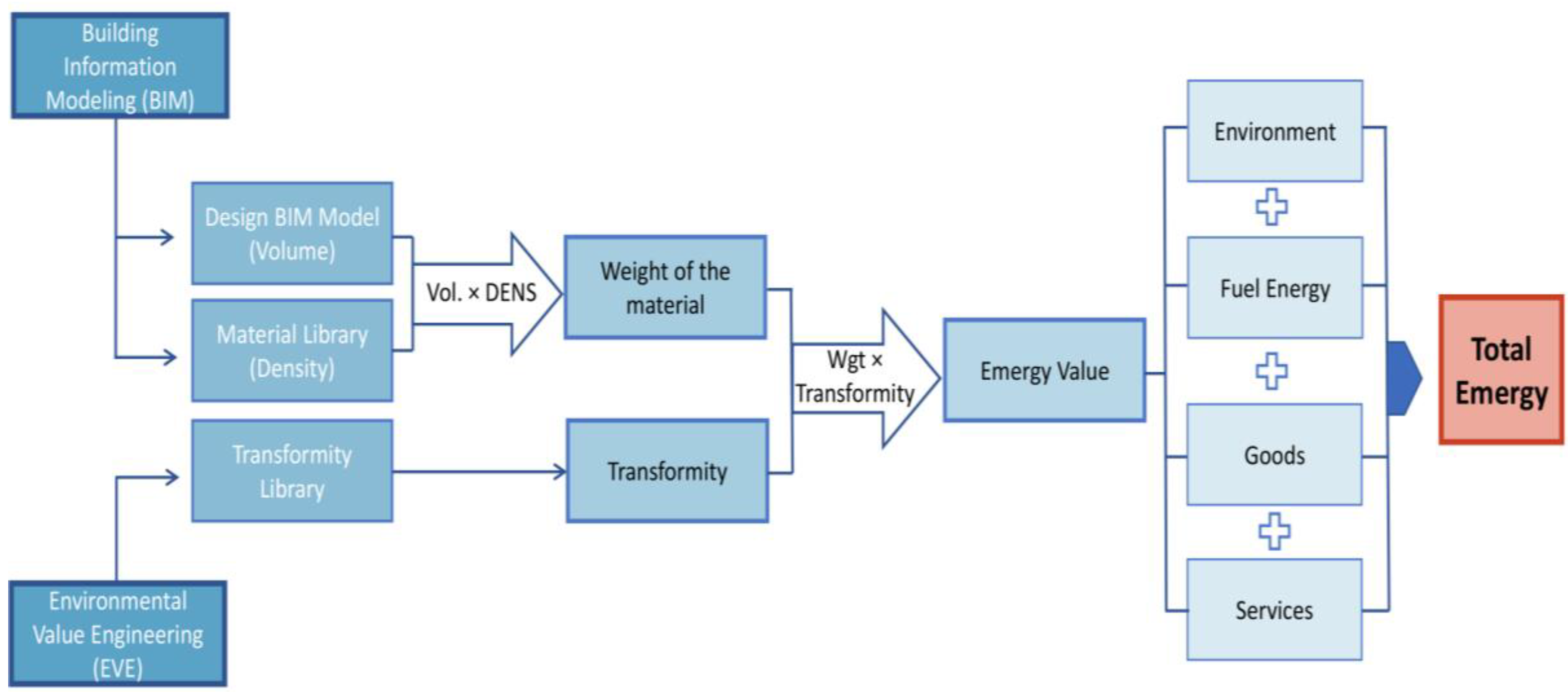


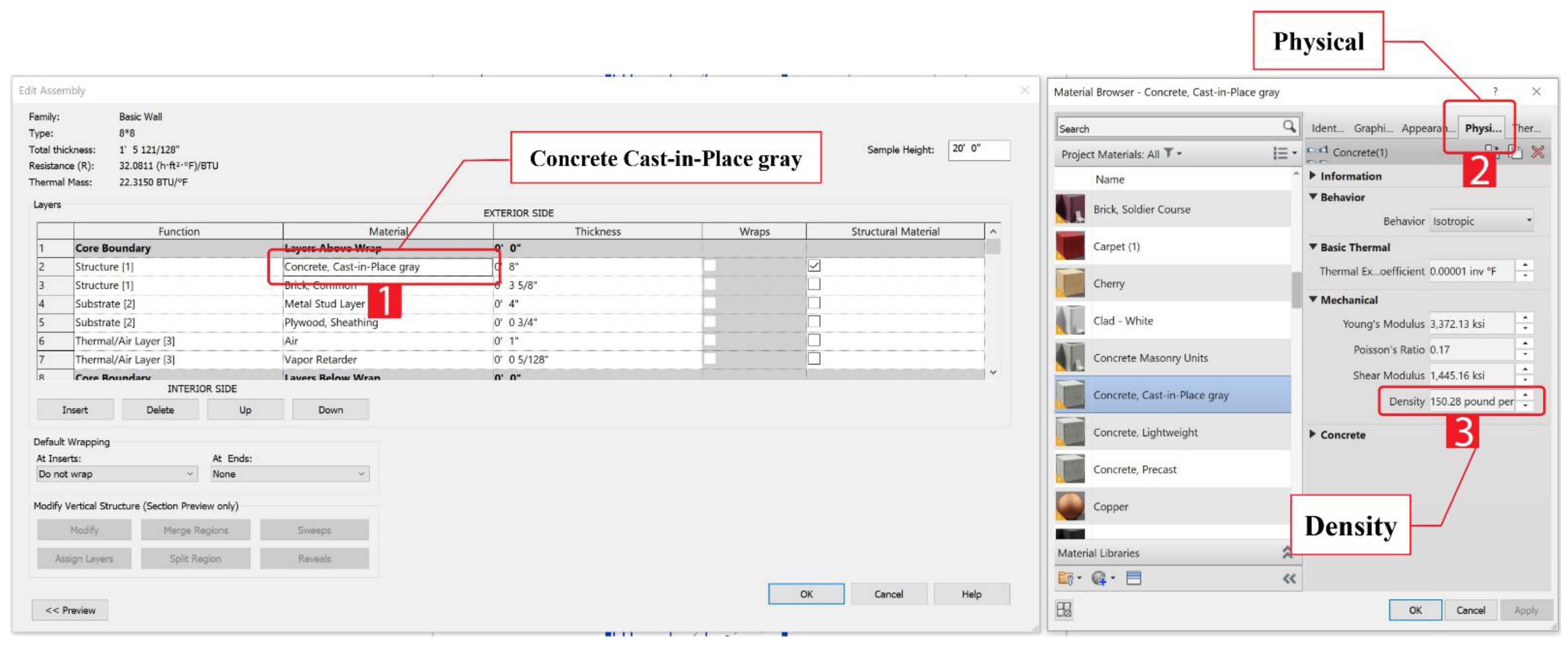

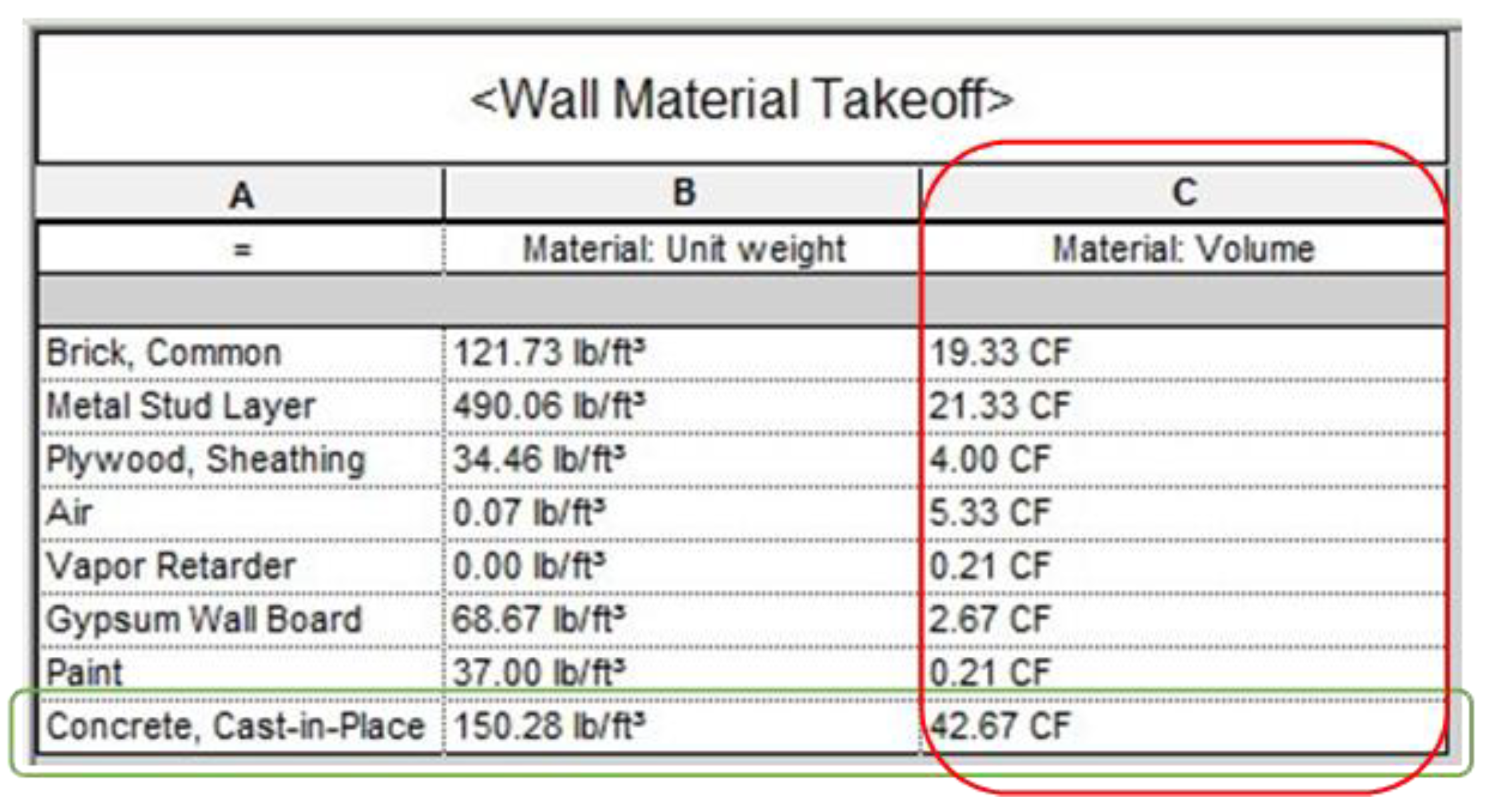
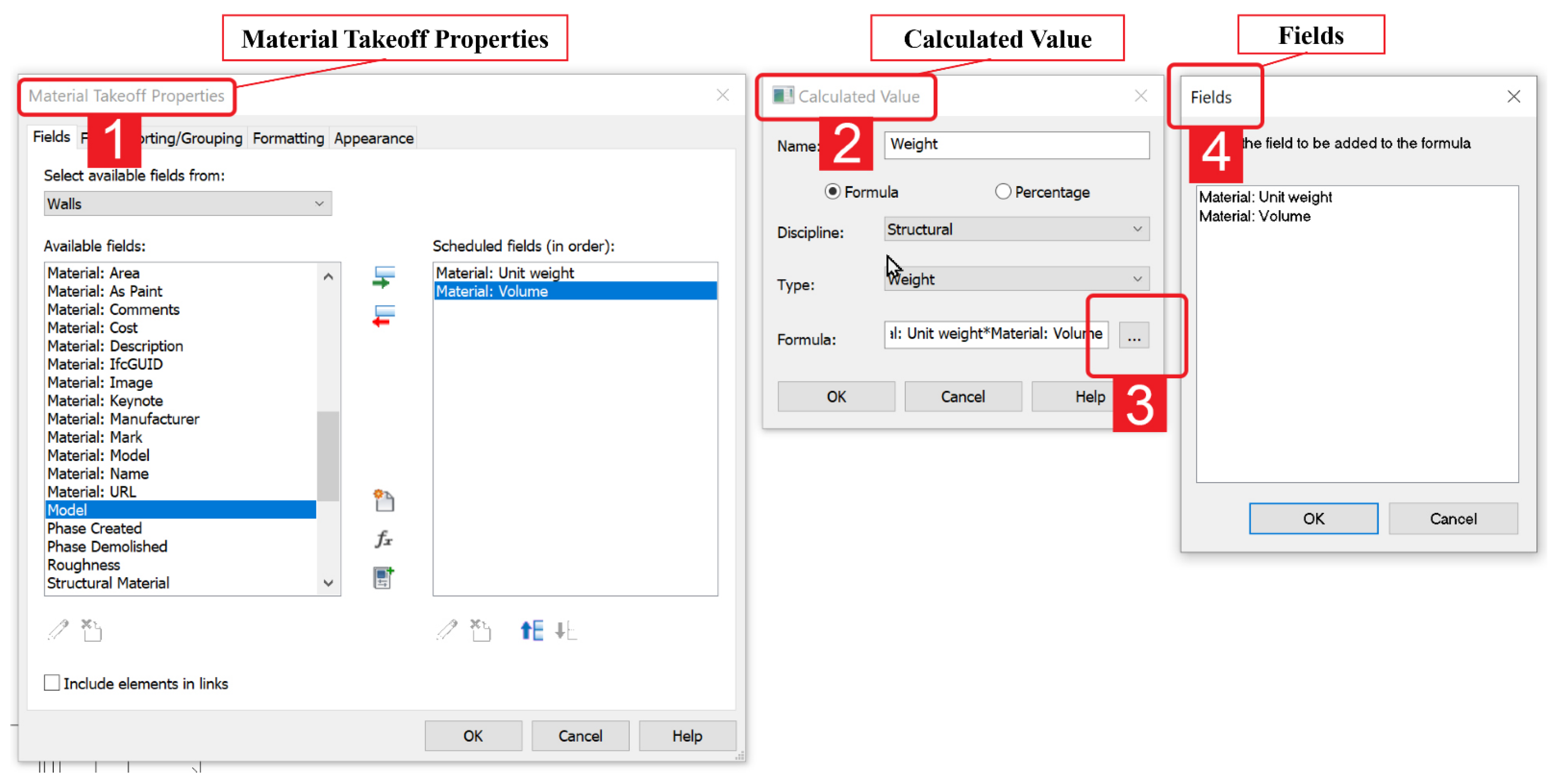

| Category | Limitations of Energy Analysis (EA) | EMERGY Analysis (EmA) as a Potential Alternative |
|---|---|---|
| Definition | Energy analysis in BIM is mainly based on R-value (material’s ability to resist the heat) of building envelope materials, heating loads, cooling loads, appliances, and lighting loads of the building. Limitation: does not include the energy requirements in all phases | Emergy analysis expresses all energies in the form of solar emergy |
| Application | Operational energy analysis, import-export balances | Net energy analysis, import–export balances |
| Connection to economics | Mostly conventional: combine EA results with “right” prices (market prices). Limitation: Market dependent and neglects environmental dependencies | Strong connection through the conversion of EMERGY to monetary equivalents. |
| Transformity | Embodied energy = the direct and indirect energy required to produce a good, service, or entity. Limitation: EA quantifies indirect energy, but it does not account for energy of different types. | The EMERGY required to produce a good or service divided by the energy of the good or service equals its transformity |
| Inclusion of human labor | It does not include energy cost of human labor. It only considers the market value of energy cost. Limitation: No direct human labor cost is only considered | Account for the labor as labor produces goods and services |
| Inclusion of renewable energy | EA was originally developed for fossil and hydro energy, but renewable energy can easily be included if needed Limitation: Energy analysis considers renewable energy as free | Because renewable energy accounts for roughly half the total energy driving the combined system of humanity and nature, EMA routinely includes it |
| Material | Transformity |
|---|---|
| Aluminum ingots (g) | 1.60 × 1010 (sej/J) |
| Concrete (g) | 9.99 × 108 (sej/J) |
| Oil(J) | 5.30 × 104 (sej/J) |
| Machinery (g) | 6.70 × 109 (sej/J) |
| Wood (J) | 3.49 × 104 (sej/J) |
| Glass (g) | 8.40 × 108 (sej/J) |
| Material: Name | Unit | Weight | Transformity | Emergy (SEJ) |
|---|---|---|---|---|
| Brick, Common | lb | 2353.5 | 1.71 × 109 | 4.02 × 1012 |
| Metal Stud Layer | lb | 10454.56 | 3.97 × 106 | 4.15 × 1010 |
| Plywood, Sheathing | lb | 137.84 | 6.15 × 106 | 8.48 × 108 |
| Air | lb | 0.4 | 0.00 × 100 | 0.00 × 100 |
| Vapor Retarder | lb | 0 | 0.00 × 100 | 0.00 × 100 |
| Gypsum Wall Board | lb | 183.12 | 2.10 × 107 | 3.84 × 109 |
| Paint | J | 7.77 | 7.06 × 106 | 5.49 × 107 |
| Concrete, Cast-in-Place | lb | 6412.07 | 9.99 × 108 | 6.41 × 1012 |
Publisher’s Note: MDPI stays neutral with regard to jurisdictional claims in published maps and institutional affiliations. |
© 2021 by the authors. Licensee MDPI, Basel, Switzerland. This article is an open access article distributed under the terms and conditions of the Creative Commons Attribution (CC BY) license (https://creativecommons.org/licenses/by/4.0/).
Share and Cite
Paneru, S.; Foroutan Jahromi, F.; Hatami, M.; Roudebush, W.; Jeelani, I. Integration of Emergy Analysis with Building Information Modeling. Sustainability 2021, 13, 7990. https://doi.org/10.3390/su13147990
Paneru S, Foroutan Jahromi F, Hatami M, Roudebush W, Jeelani I. Integration of Emergy Analysis with Building Information Modeling. Sustainability. 2021; 13(14):7990. https://doi.org/10.3390/su13147990
Chicago/Turabian StylePaneru, Suman, Forough Foroutan Jahromi, Mohsen Hatami, Wilfred Roudebush, and Idris Jeelani. 2021. "Integration of Emergy Analysis with Building Information Modeling" Sustainability 13, no. 14: 7990. https://doi.org/10.3390/su13147990







